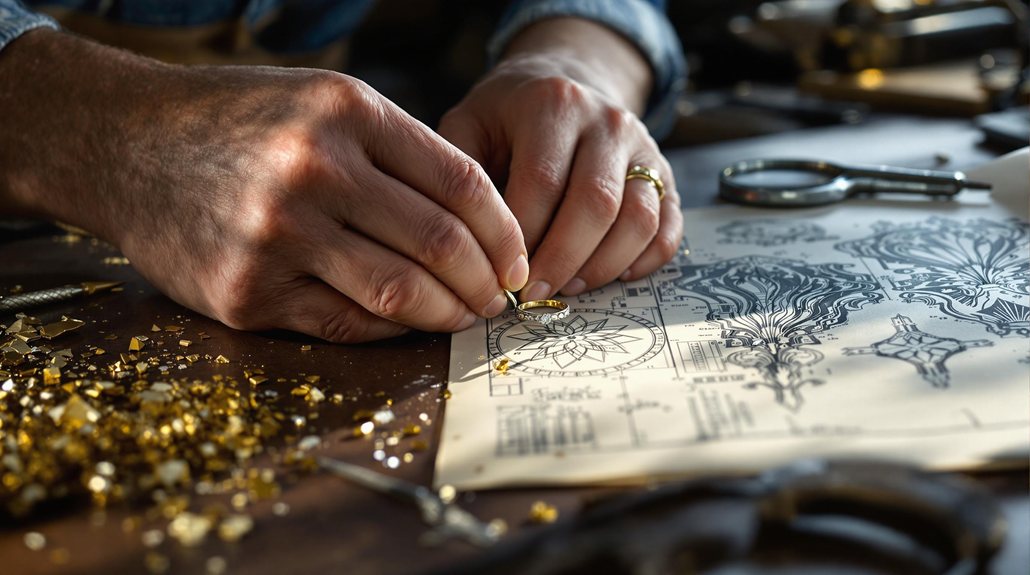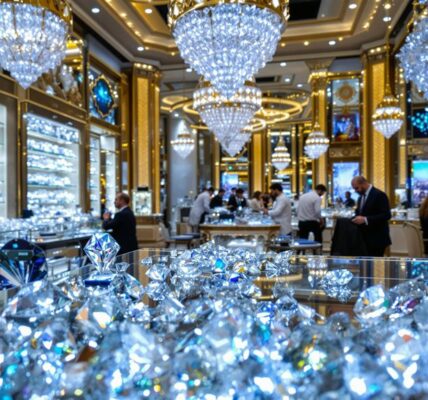UK Jewellery Industry Responds to Government’s Industrial Strategy Consultation
The UK jewellery industry has provided detailed feedback on the government’s industrial strategy consultation, representing its 7,000 independent retailers and manufacturing sector. The response addresses critical challenges including supply chain disruptions, rising raw material costs, and post-Brexit trade complexities. Currently contributing £9.44 billion annually to the economy, the sector emphasises the need for improved investment opportunities and training support for SMEs. The industry’s recommendations align with key focus areas of net zero initiatives, regional growth, and economic resilience. The establishment of an Industrial Strategy Council signals promising developments for this essential sector’s future.
Article Contents
- 1 Main Highlights
- 2 Current State of UK Jewellery
- 3 Industry Growth and Market Trends
- 4 Jewellery Industry Operational Pressures
- 5 Government Strategy and Industry Response
- 6 Future Outlook and Opportunities
- 7 Frequently Asked Questions
- 7.1 What Certifications Are Required to Become a Jewellery Manufacturer in the UK?
- 7.2 How Do UK Jewellery Manufacturers Ensure Ethical Sourcing of Precious Materials?
- 7.3 What Insurance Requirements Exist for UK Jewellery Manufacturing Businesses?
- 7.4 How Does Brexit Impact Trade Relationships With European Jewellery Suppliers?
- 7.5 What Environmental Regulations Must Jewellery Manufacturers in the UK Comply With?
- 8 Our Concluding Thoughts
Main Highlights
- Industry leaders underscore the sector’s £9.44 billion annual contribution and urge for increased support for 58,000 jewellery sector jobs.
- The jewellery sector stresses the need for SME training programmes and investment opportunities to address declining industry growth.
- Manufacturers emphasise the urgency of tackling post-Brexit trade barriers affecting supply chains and access to international markets.
- Industry representatives advocate for sustainable practices and net-zero initiatives while requesting government support for technological innovation.
- The sector proposes the establishment of specialised training centres to maintain craftsmanship standards and support regional growth initiatives.
Current State of UK Jewellery
The UK’s jewellery industry presents a highly fragmented market landscape dominated by small enterprises and workshops, with domestic jewellers fulfilling only half of the national demand.
With over 7,000 independent retail stores operating nationwide, the sector showcases a rich variety of artisan craftsmanship alongside international luxury brands.
Recent market data reveals significant shifts in consumer preferences and industry performance. December 2023 witnessed a 10.7% decline in total hallmarking compared to the previous year, with notable decreases in 18ct gold and sterling silver. The palladium items surged by nearly 60% during this period, indicating shifting market preferences.
However, the industry demonstrates resilience through adaptation to changing market demands, particularly in sustainable and ethical practices.
Small firms employing fewer than five people constitute the largest market segment, reflecting the industry’s traditional roots while embracing modern innovations.
Consumer spending on jewellery remains strong, with per capita spending reaching €68.7, significantly exceeding the EU average of €48.3.
The sector’s structure encompasses different specialised segments, from traditional manufacturers to contemporary design houses.
This diversity allows the industry to cater to evolving consumer preferences, with particular emphasis on ethical sourcing, personalisation, and digital integration.
The market’s ability to blend traditional craftsmanship with modern retail approaches positions it distinctly in responding to current market challenges.
Industry Growth and Market Trends
Recent analysis of the UK jewellery industry reveals a complex growth trajectory, marked by significant export values of £3.2B in 2022 yet facing a projected contraction of 0.7% CAGR through 2025.
The export dynamics position Britain as the 11th largest jewellery exporter globally, while simultaneously ranking as the 7th largest importer with £3.77B in purchases, reflecting the market’s dynamic international trade position. Premium data access through statistical platforms enables comprehensive tracking of these trade patterns. Key partnerships with Switzerland and Qatar generated over £1B in exports during 2022.
Consumer preferences are rapidly evolving, driven by three key trends: sustainability, digital transformation, and personalisation.
The rise of eco-friendly products and lab-grown diamonds demonstrates a clear shift towards ethical consumption, while e-commerce continues to reshape traditional purchasing patterns.
Despite current challenges from inflation and cost-of-living pressures, the industry shows promising signs of recovery as consumer confidence gradually rebuilds.
Looking ahead, the market landscape is set to transform through technological innovations, particularly in augmented reality for online shopping experiences.
While traditional and bridal jewellery segments face headwinds from changing social patterns, the industry’s anticipated growth over the next five years suggests resilience and adaptability in meeting evolving market demands.
Jewellery Industry Operational Pressures
While market dynamics show signs of resilience, UK jewellery manufacturers face mounting operational pressures that threaten their long-term sustainability. The industry grapples with significant supply chain disruptions, particularly in diamond and gemstone imports from India, while currency volatility continues to drive up costs. The record low pound against the US dollar has intensified these challenges for manufacturers. With 1,406 businesses currently operating in the sector, competition remains fierce and puts additional pressure on operational efficiency.
| Challenge | Impact |
|---|---|
| Supply Chain Issues | Increased import costs, delivery delays |
| Raw Material Costs | Rising gold and silver prices strain margins |
| Consumer Behaviour | Reduced spending due to cost-of-living crisis |
| Market Competition | Declining industry growth, intense rivalry |
These challenges are further complicated by shifting consumer behaviour patterns, with traditional jewellery sales suffering from declining marriage rates. The emergence of lab-grown diamonds presents both an opportunity and a threat, as manufacturers must adapt their production strategies to meet changing market preferences.
Manufacturers also face regulatory hurdles, particularly in post-Brexit trade relationships with the EU. The industry’s heavy reliance on imports makes it especially vulnerable to policy changes and trade restrictions. Moreover, rising operational costs force difficult decisions between maintaining competitive pricing and preserving profit margins, creating a complex landscape for UK jewellery producers.
Government Strategy and Industry Response
As part of its broader economic vision, the UK government has unveiled an ambitious industrial strategy identifying eight growth-driving sectors, with the creative industries – including jewellery manufacturing – positioned as a key focus area.
The strategy emphasises support for net zero initiatives, regional growth, and economic resilience, marking a significant shift in government priorities.
Past attempts at industrial strategies have shown limited success, requiring careful consideration of implementation approaches.
In response, the UK Jewellery, Silverware, and Allied Crafts Roundtable has actively engaged in industry collaboration through their submission to the Department for Business and Trade.
Their input highlights the sector’s substantial £9.44bn annual contribution to the economy and its role in supporting over 58,000 jobs.
The sector’s commitment to skilled craftsmanship has been vital in maintaining its competitive edge in both domestic and international markets.
Key recommendations include improved investment opportunities and streamlined training support for SMEs.
The government plans to establish an independent Industrial Strategy Council to guarantee long-term stability and effectiveness.
This approach includes targeted policy interventions and partnerships with businesses, devolved governments, and regional stakeholders.
The focus on regulatory innovation and skill development, particularly through initiatives like the Craft T-Level pathway and the Goldsmiths’ Institute at Aston University, demonstrates a commitment to fostering sustainable growth in the jewellery sector.
Future Outlook and Opportunities
Charting the future of Britain’s jewellery sector reveals promising growth trajectories, with projections indicating market revenues of £7.7 billion by 2030 and a steady 5% compound annual growth rate. The industry’s transformation is driven by sustainable practices and technological innovations, with consumers increasingly favouring recycled metals and conflict-free gemstones. The average UK consumer demonstrates strong market participation with £300 worth of jewellery in their personal collections. Ring products continue to dominate the market with a revenue share of 36.07%.
| Opportunity | Impact | Market Response |
|---|---|---|
| Lab-grown diamonds | Eco-friendly alternative | Growing consumer adoption |
| AR technology | Improved shopping experience | Virtual try-ons elevate sales |
| Silver exports | 27% growth rate | New markets in India and Africa |
The sector’s digital evolution continues to break down traditional barriers, with e-commerce platforms enabling jewellers to reach international markets more effectively. Augmented reality solutions are revolutionising the customer experience, allowing freedom of choice through virtual try-ons and customisation options. The rise of sustainable alternatives, particularly lab-grown diamonds, presents significant opportunities for growth while meeting increasing consumer demand for ethical products. This combination of technological advancement and environmental consciousness positions the UK jewellery industry for sustained expansion, particularly in emerging markets where British craftsmanship commands premium value.
Frequently Asked Questions
What Certifications Are Required to Become a Jewellery Manufacturer in the UK?
Critical certifications include hallmarking compliance, manufacturing standards verification, RJC certification, product safety regulations, and quality assurance protocols through recognised bodies like Assay Offices and SCS Global Services.
How Do UK Jewellery Manufacturers Ensure Ethical Sourcing of Precious Materials?
Like threads in a tapestry, jewellers weave ethical sourcing through strict supplier audits, RJC certifications, fair trade partnerships, and transparent documentation tracking precious materials from mine to market.
What Insurance Requirements Exist for UK Jewellery Manufacturing Businesses?
Jewellery manufacturers require comprehensive coverage, including product liability insurance, business interruption protection, and all-risks physical loss coverage to safeguard operations, stock, and protect against third-party claims.
How Does Brexit Impact Trade Relationships With European Jewellery Suppliers?
Brexit has imposed new trade tariffs and customs complexities, disrupting established supply chain relationships with EU jewellery suppliers, leading to increased costs, longer delivery times, and the need for alternative sourcing strategies.
What Environmental Regulations Must Jewellery Manufacturers in the UK Comply With?
In a sea of endless regulations, jewellery manufacturers must comply with REACH standards, implement sustainable practices for precious metals, maintain waste management protocols, and guarantee ethical material sourcing.
Our Concluding Thoughts
The UK jewellery industry finds itself at an important crossroads as manufacturers and artisans prepare to tackle modern challenges. The government’s industrial strategy consultation has initiated meaningful dialogue between stakeholders, leading to actionable recommendations for sustainable growth. With technological advancement, skilled workforce development, and strengthened international trade relationships, the British jewellery sector is well-positioned to maintain its sterling reputation and competitive edge in the global marketplace. Moreover, the UK jewellery industry has recognized the need to learn from international best practices, with a particular focus on the Indian jewellery sector analysis. By studying the strategies and innovations of one of the largest jewellery markets in the world, British manufacturers and artisans can adapt and develop new techniques to meet the demands of the modern consumer. This cross-pollination of ideas and expertise will undoubtedly contribute to the continued success and sustainability of the UK jewellery industry.




